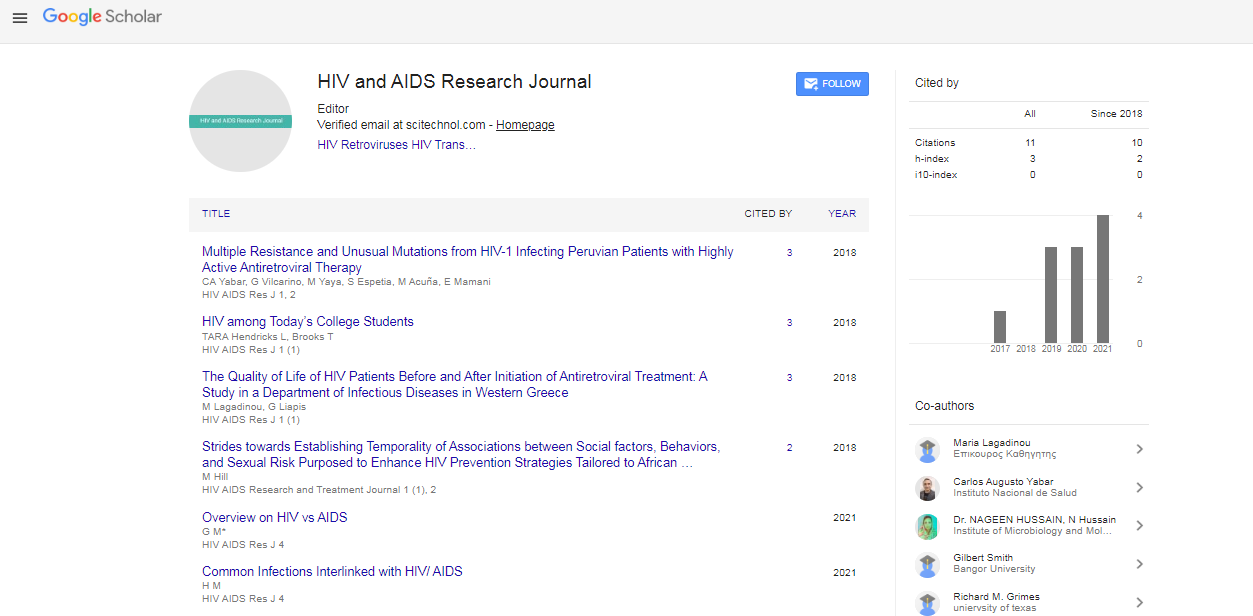Perspective, Hiv Aids Res J Vol: 6 Issue: 4
HIV Symptoms: Varied Presentations, Clinical Manifestations, and Disease Progression
Henry Philips*
1Department of Medicine, Brown University, Rhode Island, USA
*Corresponding Author: Henry Philips,
Department of Medicine, Brown
University, Rhode Island, USA
E-mail: philiphens@gmail.com
Received date: 04 December, 2023, Manuscript No. HARJ-24-124121;
Editor assigned date: 06 December, 2023, PreQC No. HARJ-24-124121 (PQ);
Reviewed date: 20 December, 2023, QC No. HARJ-24-124121;
Revised date: 28 December, 2023, Manuscript No. HARJ-24-124121 (R);
Published date: 05 January, 2024 DOI: 10.4172/Harj.1000134
Citation: Philips H (2024) HIV Symptoms: Varied Presentations, Clinical Manifestations, and Disease Progression. HIV AIDS Res J 6:4.
Description
Human Immunodeficiency Virus (HIV) infection is characterized by a spectrum of symptoms that vary widely among individuals. Understanding these symptoms, their progression, and their implications is crucial for early detection, appropriate management, and improved outcomes.
Acute HIV infection
Following exposure to HIV, individuals may experience an acute phase of the infection. This phase, often referred to as acute retroviral syndrome or seroconversion illness, occurs within the first few weeks after exposure and resembles a flu-like illness. Common symptoms during this phase may include:
Fever: Often accompanied by chills or night sweats.
Fatigue: Profound tiredness and lethargy.
Rash: A maculopapular rash, often appearing on the trunk or limbs.
Sore throat: Swelling or discomfort in the throat.
Muscle and joint pain: Aching muscles and joints.
Swollen lymph nodes: Enlargement of lymph nodes, particularly in the neck, groin, or armpits.
Headache: Persistent or severe headaches.
It's important to note that not everyone experiences these symptoms, and they can often be mistaken for other common illnesses.
Clinical latency stage
After the acute phase, HIV enters a clinical latency stage, also known as the asymptomatic or chronic phase. During this stage, individuals may not experience any noticeable symptoms for an extended period, which can last for years. Despite the absence of symptoms, HIV remains active and it continues to replicate, gradually damaging the immune system.
Symptomatic HIV infection (advanced HIV/AIDS)
As HIV progresses and the immune system becomes increasingly compromised, individuals may develop symptomatic HIV infection, indicating the progression to AIDS (Acquired Immunodeficiency Syndrome). Symptoms during this phase can be diverse and indicative of the body's vulnerability to opportunistic infections and certain malignancies. These symptoms may include:
Recurrent infections: Persistent or recurrent infections, such as pneumonia, tuberculosis, oral thrush, and chronic diarrhea, which are typically indicative of a weakened immune system.
Weight loss and wasting: Unexplained weight loss, muscle wasting, and fatigue.
Neurological symptoms: Cognitive impairment, memory loss, and neurological disorders.
Skin problems: Persistent rashes, skin lesions, or sores.
Respiratory symptoms: Chronic cough, difficulty breathing, and respiratory issues.
Gastrointestinal issues: Nausea, vomiting, abdominal pain, and diarrhea.
Opportunistic infections: Infections caused by pathogens that take advantage of a weakened immune system, such as cytomegalovirus, cryptococcal meningitis, and Kaposi's sarcoma.
Importance of early detection and treatment
Timely diagnosis and initiation of Antiretroviral Therapy (ART) play a pivotal role in managing HIV. Early treatment can significantly delay disease progression, preserve immune function, and improve overall health outcomes. Moreover, individuals on the effective ART can achieve viral suppression, reducing the risk of transmission to others.
Conclusion
The spectrum of HIV symptoms encompasses a wide range, from the acute phase resembling flu-like symptoms to the chronic and the advanced stages marked by immune compromise and opportunistic infections. Recognizing these symptoms, especially during the acute phase, is pivotal for early diagnosis, timely intervention, and initiation of antiretroviral therapy. However, it's essential to note that the absence of symptoms does not indicate the absence of HIV. Regular testing, awareness, and access to healthcare services remain crucial in managing and combating the HIV epidemic.
 Spanish
Spanish  Chinese
Chinese  Russian
Russian  German
German  French
French  Japanese
Japanese  Portuguese
Portuguese  Hindi
Hindi 